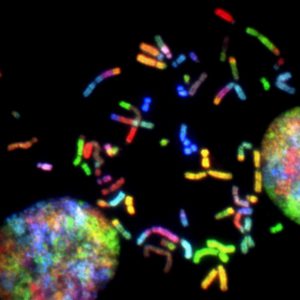What is Myelofibrosis?
Symptoms, diagnosis and treatment
Myelofibrosis is a rare cancer of the bone marrow. Learn more about myleofibrosis symptoms, diagnosis, treatment and more.
- What is myelofibrosis?
- How rare is myelofibrosis?
- Should I go to the doctor?
- What causes MF?
- What are the risk factors?
- What are the possible complications of myelofibrosis?
- Pain
- Liver complications
- Secondary tumors
- Bleeding complications
- Acute myelogenous leukemia
- How is myelofibrosis diagnosed?
- How is myelofibrosis treated?
- Anemia treatments
- Enlarged spleen treatments
- Bone marrow transplant
- How to cope with myelofibrosis
- Advocate for yourself
- Find support
- Find your own coping strategies
- Other Cancer General Info Articles
What is myelofibrosis?
Myelofibrosis is a bone marrow cancer that disrupts blood cell production. It is an uncommon cancer sometimes generically known as bone marrow cancer or blood cancer. Myelofibrosis (MF) is considered a chronic disease and a type of leukemia.
A hallmark of this disease is that it causes scarring in the body’s bone marrow, which can lead to severe fatigue due to anemia. This scarring (fibrosis) reduces platelet counts, which can increase bleeding risk. MF can also result in an enlarged spleen.
There are two type of myelofibrosis: primary and secondary. Primary myelofibrosis develops on its own and secondary myelofibrosis develops in conjunction with another bone marrow disorder.
How rare is myelofibrosis?

Myelofibrosis is considered rare or uncommon — There are fewer than 20,000 patients (men and women) in the US. It’s possible for myelofibrosis to occur at any age, but it is most often diagnosed in adults ages 60-67.
Symptoms of myelofibrosis
Because myelofibrosis is a chronic condition, some people may have it but may not experience symptoms right away. According to the Mayo Clinic, it’s unusual to feel signs or symptoms in the early stages.
More aggressive cases might require more immediate treatment.
The disease will progress over time and start to make a noticeable impact on blood cell production. Some of the more common signs and symptoms include:
- Weakness, fatigue, and shortness of breath
- Anemia
- Pain below the ribs on the left side, or a feeling of fullness
- Bruising easily
- Bleeding easily
- Night sweats
- Fever
- Bone pain
Should I go to the doctor?
If you are experiencing symptoms that do not get better, make an appointment to speak with your doctor. Because MF is not common, doctors will likely want to rule out more common diagnoses first.
What causes MF?
Like all cancers, myelofibrosis is, at its core, a mutation. Bone marrow stem cells have the ability to develop into red blood cells, white blood cells and platelets. These stem cells can develop mutations in their DNA, which can start to cause long-term blood cell production problems.
One of the most common issues is a lack of red blood cells and an overabundance of white blood cells, which causes anemia. Platelet production may reduce as well.
Bone marrow is normally spongy, but it scars in people with myelofibrosis.
In some cases, the Janus Kinase 2 (JAK2) gene mutation has been identified. Other mutations are the CALR and MPL genes. Some patients do not have an identifiable gene mutation and researchers do not know the root cause of these mutations.
If a specific gene mutation is associated with your diagnosis, it can help the medical team determine prognosis and treatment.
What are the risk factors for myelofibrosis?
What are the risk factors?
There are a few risk factors associated with MF:
- Age: Most diagnoses occur in adults age 50 and older
- Other blood cell disorder: MF is sometimes a complication that arises from essential thrombocythemia or polycythemia vera
- Chemical exposure: Industrial chemical such as toluene and benzene have been linked to MF
- Radiation exposure: There is increased risk of MF for people exposed to high levels of radiation
What are the possible complications of myelofibrosis?
This chronic condition can cause several complications.
Pain
Abdominal and back pain is the result of an enlarged spleen.
Liver complications
The spleen and the liver connect through the portal vein. An enlarged spleen leads to higher blood flow and thus higher blood pressure on the portal vein. Increased pressure can sometimes lead to ruptures and internal bleeding.
Secondary tumors
Blood cells may develop outside the bone marrow and create tumors that can lead to gastrointestinal bleeding, seizures and pressure on the spinal cord.
Bleeding complications
Thrombocytopenia (low platelet count) will likely occur as the disease progresses, which means patients are at risk for easy bleeding. Surgical procedures will require special consideration.
Acute myelogenous leukemia
Some patients with MF develop acute myelogenous leukemia, a type of blood and bone marrow cancer.
How is myelofibrosis diagnosed?
The first step from your doctor will be a physical examination and a discussion about your medical history and current symptoms. The doctor will also physically feel for an enlarged spleen.
You can also expect blood work, including a complete blood count (CBC). Indicators such as red blood cell count, white blood cell count, and platelet count can suggest anemia and elevated levels of uric acid, bilirubin and lactic dehydrogenase may also indicate MF.
Other tests that you may experience include:
- Bone marrow biopsy: A needle removes a bone marrow tissue sample and can confirm diagnosis
- Imaging: Ultrasounds, MRIs, and X-rays can help doctors fully visualize the disease
- Gene mutation testing: Pathologists will examine blood cells for specific genetic mutations, which can help guide treatment
…I noticed an unexpected lump in my abdominal region, which my doctor informed me was an enlarged spleen. This ultimately led to my diagnosis of myelofibrosis (MF)…
David D.
How is myelofibrosis treated?
Myelofibrosis treatment focuses on treating symptoms and managing the disease. Your doctor will determine if aggressive treatment or symptom management is required. If you are symptom-free, you may not have any treatment for the time being.
That all being said, there are several options that treat symptoms and help improve quality of life.
Anemia treatments
Severe anemia may require a blood transfusion or androgen hormone therapy to encourage red blood cell production. Thalidomide (Thalomid) and lenalidomide (Revlimid) may improve blood cell counts.
I was taking 25mg orally of Revlimid (chemo) every day, and I was getting 40mg of dexamethasone (steroid) on the first day and 4mg the second day. I did all that from February to June. I stopped when they were happy with the way the numbers were moving to have a kyphoplasty. We squeezed that in and moved right into the stem cell transplant in July.
I had a lot of hypotension, which was the opposite of what we thought was going to happen. I had some minor diarrhea.
Scott C., multiple myeloma

Enlarged spleen treatments
Targeted drug therapy and chemotherapy are possible pharmaceutical treatment options. A surgical option would be a splenectomy (removal of the spleen). Radiation therapy may also be able to reduce spleen size.
Bone marrow transplant
A bone marrow transplant, also called a stem cell transplant, replaces diseased bone marrow with healthy blood stem cells from a donor. Although this could potentially cure MF, it also comes with life-threatening side effects such as graft-vs-host disease.
Because many MF patients are older or have other health problems, many don’t qualify for stem cell transplant.

My mom, my brother and my sister-in-law, and my aunt were all there to support me. The nurses come in to infuse me. It basically looks like a blood transfusion. It’s a blood bag they hang on a hook and then connected it to my Hickman port underneath my shirt.
Overall, it took them maybe half an hour. It felt like nothing. I had no sensation whatsoever from this infusion.
Shari B. (Mantle Cell Lymphoma, Stage 4, Non-Hodgkin’s Lymphoma)
How to cope with myelofibrosis
Life with MF may involve pain, discomfort, fatigue, and side effects of continuous treatment.
Advocate for yourself
Because MF is an uncommon disease, it’s important to advocate for yourself and educate yourself as much as possible. Ask your doctor for more resources.
Be Your Own Advocate
– Laura, MF Patient
Find support
Lean on your family and friends and start to build a support network. There are support groups (virtual and in person) you can join. Broad cancer support groups may be helpful, but there are also groups just for myeloproliferative disorders like myelofibrosis.
Find your own coping strategies
From bloodwork to scans, to bone marrow testing, to chemotherapy, living with MF can be exhausting. Find activities that make you feel good and allow you a chance to process or put your mind on something else. Yoga, therapy and even adopting a flexible work schedule may help.

